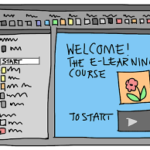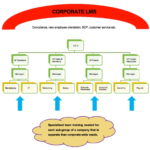by Brian Clark | DOTS LMS, learning management systems, LMS
This list is only a simple primer to help you cross check your Learning Management System selection process. We have developed a very detailed requirement analysis for undertaking a selection process for companies researching a new or replacement LMS.
Features are usually front of mind. It is easy to go for the LMS with the most features, however these features may not map to your requirements. Features that are poorly designed and lack usability will only bring frustration to your administrators and users. Be clear on the features and functions you require and then test them out with scenarios. I recommend you ask the potential LMS vendors about their product development roadmap. When you review the roadmap you will be able to identify current gaps (if any) as well as where the vendor is focusing their development resources.

Customer support has a great deal of variability in the LMS world. Most of the larger enterprise vendors have documented service level agreements as part of their licensing documents. There are some enterprise vendors that will also negotiate service level agreements and this may incur additional costs. On the other end of the spectrum are vendors that offer a standard level of customer support and more lengthy response and escalation times. The main point here is to ensure you will get the support level that makes sense for your business and its requirements.
Integration with your existing and future information systems may not be on your initial selection criteria, however it should be. Whether you wish to integrate as part of the initial roll-out or later on, you do not want to be restricted in the future when you need to share data with your payroll, HRIS, CRM or other type of platform. You may also want to integrate using LDAP, SAML, Active Directory etc. These integrations may make populating and keeping your users up to date much easier.
Pricing models in the LMS market are highly variable. For the most part they are based on user numbers but there are vendors that throw other variables in the mix such as number of administrators, number of courses, enrolments etc. You may discover at some point in the future that these extra variables may be restrictive from a cost point of view. If you need to scale your system, it is best to be very clear on what costs are going to be incurred.
Mobile friendly learning management systems are the norm now. A web based LMS should be accessible by learners using mobile phones and tablet devices. The differences here tend to be based on solutions that use apps or those that have an online portal or a responsive design. You want to make sure the user interface for the mobile user is still easy to navigate.
If you are considering your first LMS or seeking a replacement, we can help you out with our research and selection services. We have comprehensive documentation on system requirements, workflows and business case models. We have assisted a wide range of clients in a number of industries select and implement the right Learning Management solution.
- Mining
- Construction
- Banking and Finance
- Energy
- Healthcare
- Government
- Aviation
by Brian Clark | learning management systems, LMS
It is difficult to undertake a selection process for a software system that is as feature rich as an enterprise learning management system, (LMS). If you are an organisation that can get by with one of the many less capable LMS available you do not have as much at risk. Even with a fully considered and scoped out business requirements document, there are still some blind spots that can throw a spanner in an otherwise well planned LMS procurement process.
This is a list of the most common issues that often get discovered after an LMS has been implemented. In some cases these issues were not forecast or anticipated and in others the vendor committed them to a development roadmap that has not been met.
- Your users, contractors, temporary personnel and employees need to upload files as proof of skills or competence. You want to make this a self service capability but file uploads and validity periods are not included in your LMS. This is a real problem when you have large contracting workforces who arrive at work with various credentials to undertake work. You do not want to devote your precious L & D and administration resources to uploading files if you can avoid it.
- The LMS does not have extensive integration capabilities. The API may be limited or not be as pervasive in the LMS as first thought. You may discover this when you upgrade other systems or simply want to share data with a data warehouse, payroll or rostering software.
- Your people move around a bit and you want an easy way to move people into different business units, departments and job roles without losing historical data or jumping through hoops to adjust your organisational structure due to promotions, contract changes, relocations, terminations, acquisitions etc.
- Your compliance requirements are complex and this impacts workflows, pre-requesites, co-requesites, validity periods, gap analysis reporting, notifications, alerts and many other features you need to ensure you are minimising risk from compliance issues. This is an area that requires very careful consideration and scenario testing. If your business has multiple sites, can you filter reports to run against specific user populations?
- The learning experience needs to be as seamless and automated as possible to reduce administration tasks maintaining your LMS. Learning and activity sequencing is critical to this. At some point you will want to set up a series of ‘if this, then that’ sequences for learning pathways and programs.
- To maximise productivity you want to decentralise some administrative and reporting to those closest to the workforce. You want to ensure permissions, access, reporting and other administrative tasks can be cascaded down the organisation as opposed to having it all being done centrally.
- Learning plans may be mandatory for a particular job role, voluntary or part of a development plan. Ideally you can assign multiple learning plans to a person that can operate concurrently. You may have a graduate intake, induction and learning plans for a particular job role all assigned to a person.
If you need some advice or a business requirements checklist, please get in touch. We are happy to share our collective knowledge without trying to push you into one LMS or another.
by Brian Clark | learning and development, learning management systems, LMS
Do you have a sense that interest and engagement with your LMS is in decline? Is it only a sense or have you been confronted with metrics showing declining enrolments, logins and participation? These are some ideas on how you can reverse the decline trend and ignite interest and engagement with your elearning programs.
These ideas vary in complexity and cost to implement. I suggest you consider these ideas in the context of both your target audiences and the resources you have available. 
- Add social to your elearning. This may be in your LMS, using social platforms or a mixture of both. You might be surprised to find that a Facebook Group focused on a learning topic or general subject matter will prompt higher participation rates and interest. In both a social platform and your LMS make sure you encourage question and answer, forums, course ratings and surveys. Some organisations have been successful encouraging social collaboration by rating questions, answers and published content and offering awards.
- Mobile learning is no longer an option. You will compromise your participation rates without enabling people to access learning on mobile and tablet devices. Make sure your learning is always available with fast access and mobile is the way to achieve this. Make sure there is learning available that does not require an enrolment process or other barrier to entry.
- People do not have the time or attention span to endure long online learning modules. Make sure your learning content is short and to the point. Short modules can be combined to create longer courses. I recommend modules of 5 to 10 minutes duration. If you go much beyond this a person will lose focus and attention. Your people may be accessing learning on their mobile devices in all sorts of environments so you want to make it easy for them to start and complete a module with the greatest chance for success.
- You can ‘gamify’ your elearning. This does not have to be overly complicated. You simply determine what the parameters of the game are and then implement measurement and tracking. It can be assigning points to courses and people accumulate points as they complete courses. You can award points for participation in social collaboration and sharing. There are many ways to do this. Remember you are not wanting to encourage a toxic competitive culture, you want to make learning fun.
- Case studies are a good way to capture interest. Case studies are great for learning concepts since people can relate to them. You can add coaching and social collaboration to case study learning for even more impact.
If you are facing declining participation rates in your organisation’s elearning you may have reached a fork in the road. You have the choice of the carrot or the stick. The carrot is always more effective to create change and encouraging people to participate in learning is no different. I hope these five ideas will help you out.
by Brian Clark | learning management systems, LMS
Despite the advances in LMS technology and the enormous range of features being added to learning management systems, some organisations still find there are gaps in meeting their learning strategy objectives.
 An organisation facing this reality will often search for a new LMS to meet their needs. This process may be costly in time and financial resources. These are a few ideas that warrant consideration before taking the plunge.
An organisation facing this reality will often search for a new LMS to meet their needs. This process may be costly in time and financial resources. These are a few ideas that warrant consideration before taking the plunge.
- Make sure you have your current LMS configured correctly. Have you changed your configuration to meet new requirements?
- Have you kept pace with updates from your vendor?
- If reporting is not delivering what you need, have you considered integrating with a third party reporting tool?
If you are looking to build a continuous learning framework, the LMS is a great platform to contribute to the framework, but it may need to be supplemented with other tools and processes. You may want to consider these options as well before ditching your current LMS.
- Consider offering micro-learning in your LMS. Make the learning fun and always available by not being linked to sessions and enrolment processes.
- Try using social media to foster greater collaboration and teamwork. The social features in learning management systems vary widely. Social platforms offer a number of ways to engage your people without cost and with a good chance of widespread adoption. YouTube is an incredible resource that is under-utilised for learning across an extended enterprise.
- Offer classroom and online follow-up to your learning programs. We have achieved great results using collaborative communities of practice and expert areas to foster ongoing learning and retention.
- Personalise your learning to individuals and teams. Most learning management systems have the ability to do this to varying degrees. Change the learning programs regularly to keep people interested and engaged.
You can achieve great things as a learning professional using technology and other tools to supplement your LMS. Do not consider the LMS to be the only tool you have to achieve your learning objectives.
by Brian Clark | Business Process, learning management systems, LMS
Specific autonomous training that harmonises with corporate training objectives.
Has there ever been an example when one size truly fits all? A label that’s been stamped on everything from hats and clothing to table cloths and diapers, this type of statement couldn’t be farther from the truth.
These days it’s all about customisation and this is critical into the world of effective training. Studies show that learners may retain information very differently and this has been one of the key drivers in the widespread rapid adoption of blended learning.
This concept also holds true from a trainer’s perspective — one size does NOT fit all when it comes to team training. It is imperative that business units across an organization are equipped with the right tools to meet their specific goals and objectives. And, this often comes with unique training needs that do not always fall under the same organizational LMS umbrella.

Training should be tailored to team needs.
No two teams are alike, nor their training needs.
Every organisation has some type of hierarchy or chain of command that functions along the idea that all the individual units work together for the good of the whole. However, would it be safe to assume that sales and marketing will have very different training needs than manufacturing, safety and HR? Or, IT versus customer service?
While there will always be some cross-over in training needs, there are also a significant number of situations where specific teams need a tailored solution. Common problems teams face include:
- A lack of administrative access or control of the corporate LMS.
- The corporate LMS is too complicated for small team needs.
- The LMS does not offer administrative tools for specific user populations.
- There is an inability to customise learning paths and training for specific team requirements.
If your business is not delivering tailored training and/or performance support to specific teams and groups you may consider the following:
- Review the capabilities of your LMS to determine if you can deliver tailored training and user experiences to specific teams and groups.
- If your LMS has these capabilities but they are not utilised, consult your vendor or support provider to determine the scope of activating this set of capabilities.
- If your LMS does not have this capability you may wish to explore other options. The use of learning management systems across the extended enterprise is now more common and proving an effective business development and competitive differentiator.
If you would like further information on this subject please get in touch with us. We can provide ideas on how to roll out tailored training and show you some e-learning modules designed for these types of scenarios. You may also wish to have a look at an LMS configured for an extended enterprise deployment.





